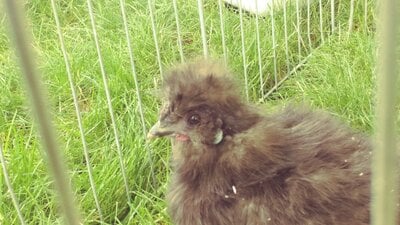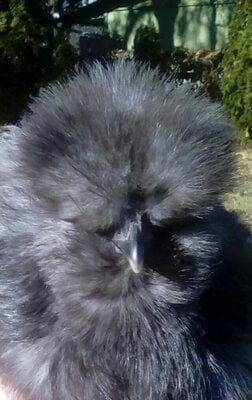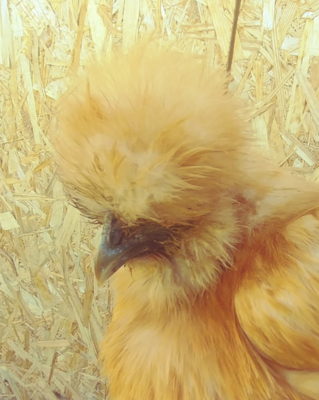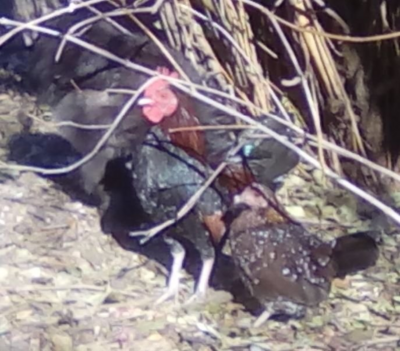Hi everybody!
When I first got my silkie chicks I searched for everything about them, especially about sexing them, as I had heard that silkies are very hard to sex. Surprisingly, once I tried it, it didn't seem that hard.
Searching around, I found that there are no articles on how to sex silkies on BYC (BackYardChickens)!!! I decided that I would do it myself.
Of course, there is vent sexing, but that should only be done by an expert as it can be dangerous to the chick. Vent sexing is what most stores and hatcheries use to confirm the gender of their chicks, and it can only be attempted on day one of the chick's life. It is about 90 percent accurate, however, most hatcheries and stores in America don't use vent sexing on bantams because it's harder and the chicks seem more fragile (though for their size they seem plenty tough to me).
There is also feather sexing, but that is only accurate when the chick's parents have the right genes, and if they are from stores and hatcheries you can never be sure of that.
The methods in here can be used by anybody, no need for veterinary experience or certain genes. But remember that in sexing chicks it is all guesswork (unless you vent or feather sex correctly).
In this article I will call female chickens over a year old "hens" and under a year "pullets". Males over a year old are call "cocks" and under a year "cockerels". Rooster can refer to a male of any age. And then, of course, there is male, female, boy, and girl.
Note: the pictures in here are NOT for free use, all of them are mine or from others who I got permission from.
1. Posture
Some people use this method as their sole purpose of sexing their silkies. I prefer looking for hackles, but this is probably my second choice.
Roosters tend to stand taller than the females, even as chicks. Here are some pictures to help you understand:

You can see how the dark blue cockerel stands taller than the buff pullet.

Notice how tall and proud this cockerel stands.

Guessing by their posture, the boy is on the left and the girl on the right. (These silkie chicks are buff, but the lighting is making them look white.)

These aren't silkies (they are spangled Old English Game bantams), but I chose this picture because it is a very good demonstration of posture. You can see how the rooster stands tall while the pullet hunches by his side.
2. Combs
Combs are a biggest giveaway. Roosters always have bigger combs than females. Just remember that a rooster at two weeks at age is going to have a smaller comb than one at four weeks. The older they are, the bigger their comb.

This cockerel is about 5 months old. If your silkie's comb is this big than you can be 99.9 percent sure they are a rooster.

Dark blue silkie cockerel at 5 months.

Pullet comb at 8 months.

Blue cockerel about 8 months old.

Paint silkie pullet, 3-4 months old. Her comb shows that she a girl. (Picture provided by Hughes Wildlife Farm)

Silkie pullet almost eight months old. You can tell she is female by the small size of her comb at this age.
3. Hackles and Crests
Female pompoms are normally very fluffy and round, while the boys' crests look more pulled back, like they were brushed back.


Female above, male below. Notice how the pullet's crest feathers poof out in every direction while the cockerel's are more combed back.
Both boy and girl chickens have hackles, but rooster hackles (on silkies, often called "streamers") are much longer. Hackle feathers are the feathers on the back of your chicken's neck.

See the darker feathers that drape down around the blue cockerel's neck area? Those are the hackles/streamers.


Pullet above, cockerel below. See how the rooster's hackles are much shinier and longer.

You can see this handsome rooster's long, flowing streamers clearly in this photo, along with a huge comb and waddles. (Picture provided by BantyChooks)
4. Size
Sometimes this works, sometimes it doesn't, but most the time boys are bigger than girls. However, I have one pullet who is the same size as my smaller cockerel. This isn't the most accurate way to sex silkies, and I am going to guess that this method is right about 80 percent of the time.
Don't get confused between standard and bantam size. In the US silkies can only be found in bantam size, but in other places (such as the UK) silkies are recognized in bantam and standard size.
5. Beak Sexing
Nobody really knows if this method works or not. Some say it works almost perfectly, others claim it is useless. You should best use this as a extra method that is more for fun than anything. It was correct for three of the five silkies I tested it on.
For this there is two kinds of beaks, the 'rooster beak' and the 'hen beak'. The rooster beak is longer and straighter while the hen beak is shorter and curvier (see in the pictures below).


Male above, female below. You can see that the male's beak is strait with a sharp angle down at the end, while the female's has a gradual curve and is much shorter.
6. Behavior
First, Roosters are more bold than the girls. If you see a chick staring you strait in the eye, you can make a guess that they are male. Boys will explore more, while the girls are much more calm. This is true with most every breed of chicken.
Eventually your roosters will start doing things like "herding" and "tidbitting". Herding is when they drop their wing to a hen or pullet and shuffle around them. They also do this to other roosters to show their dominance. Tidbitting is when they pick up a peice of food in their beak, then drop it again. They do this several times, until the females notice, all the while giving the tidbitting call.

Notice how alert and bold this cockerel is.
When they are a few weeks old the roosters may get more vocal. When they start crowing they sound like they are choking and being crushed at the same time. Don't worry, they will get better. I have found that silkies crow just about as much as roosters of other breeds, and just as loud.
I have never had one, but every once in a while there is the female chicken who will crow, though it is rare.

Silkie cockerel mid-crow.
Read this article by @PippinTheChicken to learn more methods for sexing silkies! Pippin's easy guide to silkie sexing
The surest way to confirm their gender is this: if they lay an egg, they are female. You can never go wrong there!
Silkies can take quite a while to begin laying. Mine have all started when they were between 6-9 months old, but sometimes it can take over a year for them to start lay. I have found that silkies are actually very good layers, and have been told by other silkie owners that they almost always are except for when they are broody.

This is unusual behavior for any chicken, and if one of your chickens does this you should consider yourself very lucky! (Picture provided by silkiemother)
Thanks to
@BantyChooks
@Hughes Wildlife Farm
and @silkiemother
for providing pictures.
And, of course, we need to give credit to the wonderful silkies who helped. Thank you Batman, Pebbles, Dot, Peter Pevensie, Piper McCloud, Faline, Bob, Gregor, Skye Bloo, and a couple of no-name chicks.
I also need to thank Finn and Enna, the two game bantams who helped demonstrate posture.
I hope that this article will help you discover how to sex silkies! Don't be upset if you don't get it right the first few times, it takes practice and is a fun skill to develop!
When I first got my silkie chicks I searched for everything about them, especially about sexing them, as I had heard that silkies are very hard to sex. Surprisingly, once I tried it, it didn't seem that hard.
Searching around, I found that there are no articles on how to sex silkies on BYC (BackYardChickens)!!! I decided that I would do it myself.
Of course, there is vent sexing, but that should only be done by an expert as it can be dangerous to the chick. Vent sexing is what most stores and hatcheries use to confirm the gender of their chicks, and it can only be attempted on day one of the chick's life. It is about 90 percent accurate, however, most hatcheries and stores in America don't use vent sexing on bantams because it's harder and the chicks seem more fragile (though for their size they seem plenty tough to me).
There is also feather sexing, but that is only accurate when the chick's parents have the right genes, and if they are from stores and hatcheries you can never be sure of that.
The methods in here can be used by anybody, no need for veterinary experience or certain genes. But remember that in sexing chicks it is all guesswork (unless you vent or feather sex correctly).
In this article I will call female chickens over a year old "hens" and under a year "pullets". Males over a year old are call "cocks" and under a year "cockerels". Rooster can refer to a male of any age. And then, of course, there is male, female, boy, and girl.
Note: the pictures in here are NOT for free use, all of them are mine or from others who I got permission from.
1. Posture
Some people use this method as their sole purpose of sexing their silkies. I prefer looking for hackles, but this is probably my second choice.
Roosters tend to stand taller than the females, even as chicks. Here are some pictures to help you understand:
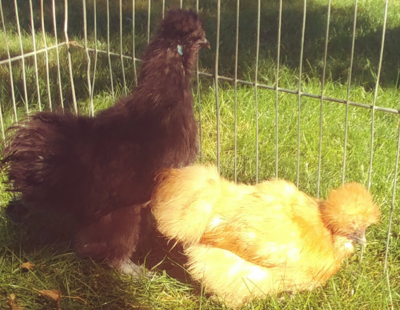
You can see how the dark blue cockerel stands taller than the buff pullet.
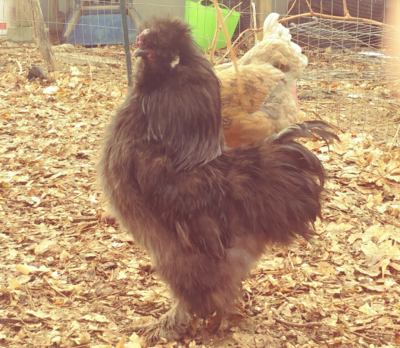
Notice how tall and proud this cockerel stands.
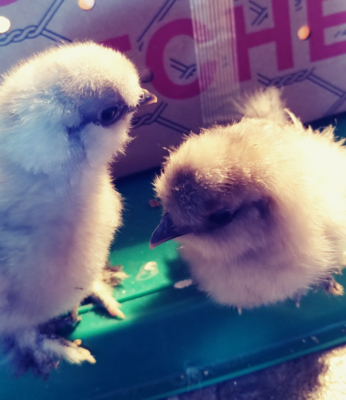
Guessing by their posture, the boy is on the left and the girl on the right. (These silkie chicks are buff, but the lighting is making them look white.)
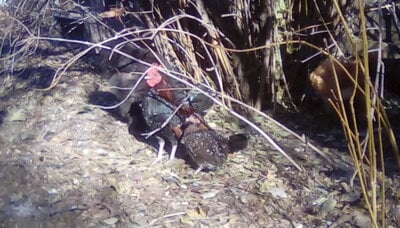
These aren't silkies (they are spangled Old English Game bantams), but I chose this picture because it is a very good demonstration of posture. You can see how the rooster stands tall while the pullet hunches by his side.
2. Combs
Combs are a biggest giveaway. Roosters always have bigger combs than females. Just remember that a rooster at two weeks at age is going to have a smaller comb than one at four weeks. The older they are, the bigger their comb.
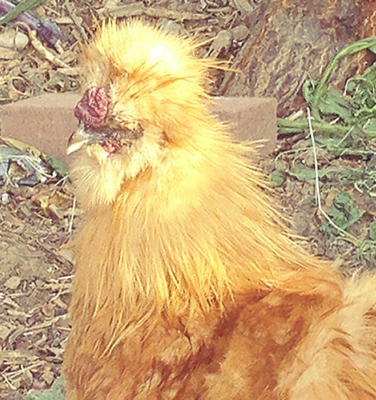
This cockerel is about 5 months old. If your silkie's comb is this big than you can be 99.9 percent sure they are a rooster.
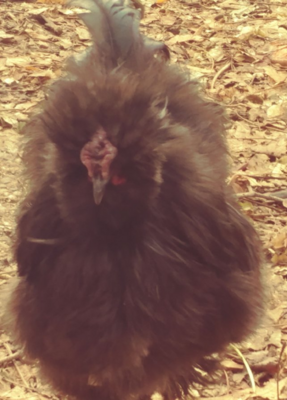
Dark blue silkie cockerel at 5 months.
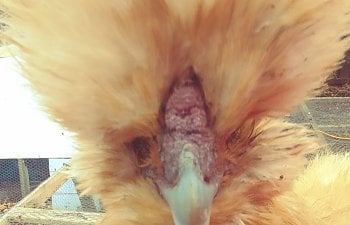
Pullet comb at 8 months.
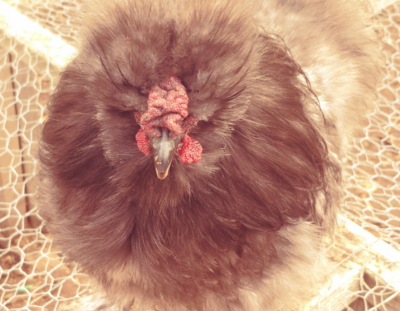
Blue cockerel about 8 months old.
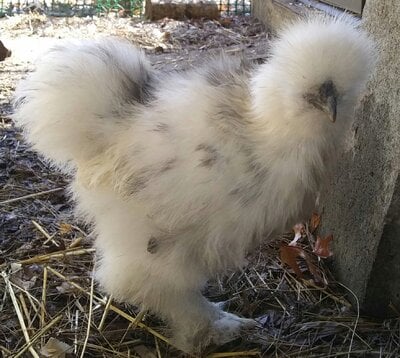
Paint silkie pullet, 3-4 months old. Her comb shows that she a girl. (Picture provided by Hughes Wildlife Farm)
Silkie pullet almost eight months old. You can tell she is female by the small size of her comb at this age.
3. Hackles and Crests
Female pompoms are normally very fluffy and round, while the boys' crests look more pulled back, like they were brushed back.
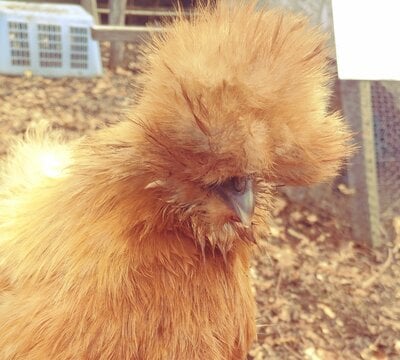
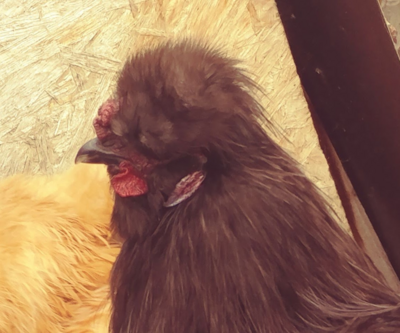
Female above, male below. Notice how the pullet's crest feathers poof out in every direction while the cockerel's are more combed back.
Both boy and girl chickens have hackles, but rooster hackles (on silkies, often called "streamers") are much longer. Hackle feathers are the feathers on the back of your chicken's neck.
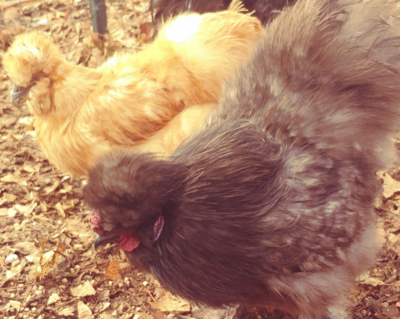
See the darker feathers that drape down around the blue cockerel's neck area? Those are the hackles/streamers.
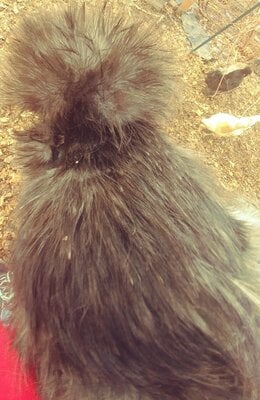
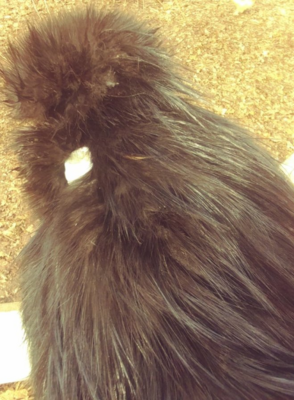
Pullet above, cockerel below. See how the rooster's hackles are much shinier and longer.
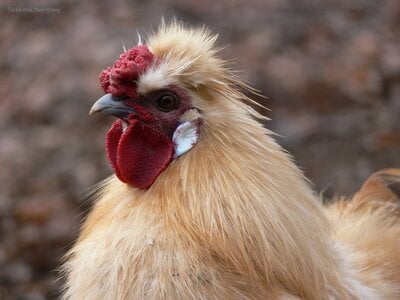
You can see this handsome rooster's long, flowing streamers clearly in this photo, along with a huge comb and waddles. (Picture provided by BantyChooks)
4. Size
Sometimes this works, sometimes it doesn't, but most the time boys are bigger than girls. However, I have one pullet who is the same size as my smaller cockerel. This isn't the most accurate way to sex silkies, and I am going to guess that this method is right about 80 percent of the time.
Don't get confused between standard and bantam size. In the US silkies can only be found in bantam size, but in other places (such as the UK) silkies are recognized in bantam and standard size.
5. Beak Sexing
Nobody really knows if this method works or not. Some say it works almost perfectly, others claim it is useless. You should best use this as a extra method that is more for fun than anything. It was correct for three of the five silkies I tested it on.
For this there is two kinds of beaks, the 'rooster beak' and the 'hen beak'. The rooster beak is longer and straighter while the hen beak is shorter and curvier (see in the pictures below).

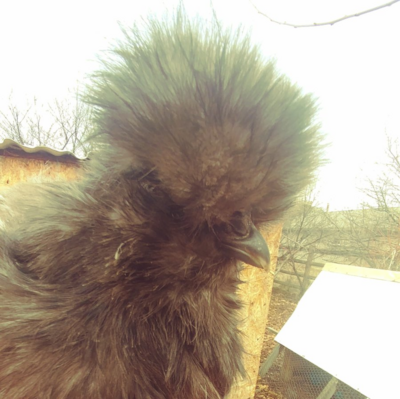
Male above, female below. You can see that the male's beak is strait with a sharp angle down at the end, while the female's has a gradual curve and is much shorter.
6. Behavior
First, Roosters are more bold than the girls. If you see a chick staring you strait in the eye, you can make a guess that they are male. Boys will explore more, while the girls are much more calm. This is true with most every breed of chicken.
Eventually your roosters will start doing things like "herding" and "tidbitting". Herding is when they drop their wing to a hen or pullet and shuffle around them. They also do this to other roosters to show their dominance. Tidbitting is when they pick up a peice of food in their beak, then drop it again. They do this several times, until the females notice, all the while giving the tidbitting call.
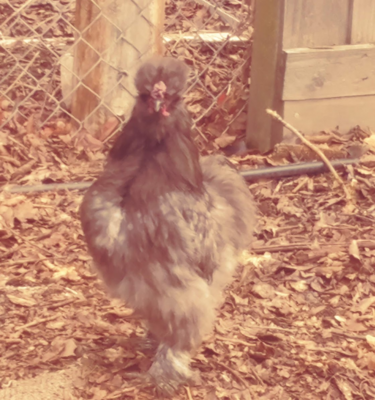
Notice how alert and bold this cockerel is.
When they are a few weeks old the roosters may get more vocal. When they start crowing they sound like they are choking and being crushed at the same time. Don't worry, they will get better. I have found that silkies crow just about as much as roosters of other breeds, and just as loud.
I have never had one, but every once in a while there is the female chicken who will crow, though it is rare.
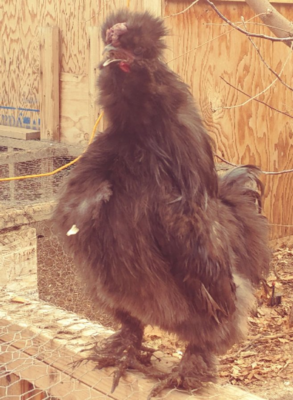
Silkie cockerel mid-crow.
Read this article by @PippinTheChicken to learn more methods for sexing silkies! Pippin's easy guide to silkie sexing
The surest way to confirm their gender is this: if they lay an egg, they are female. You can never go wrong there!
Silkies can take quite a while to begin laying. Mine have all started when they were between 6-9 months old, but sometimes it can take over a year for them to start lay. I have found that silkies are actually very good layers, and have been told by other silkie owners that they almost always are except for when they are broody.
This is unusual behavior for any chicken, and if one of your chickens does this you should consider yourself very lucky! (Picture provided by silkiemother)
Thanks to
@BantyChooks
@Hughes Wildlife Farm
and @silkiemother
for providing pictures.
And, of course, we need to give credit to the wonderful silkies who helped. Thank you Batman, Pebbles, Dot, Peter Pevensie, Piper McCloud, Faline, Bob, Gregor, Skye Bloo, and a couple of no-name chicks.
I also need to thank Finn and Enna, the two game bantams who helped demonstrate posture.
I hope that this article will help you discover how to sex silkies! Don't be upset if you don't get it right the first few times, it takes practice and is a fun skill to develop!

